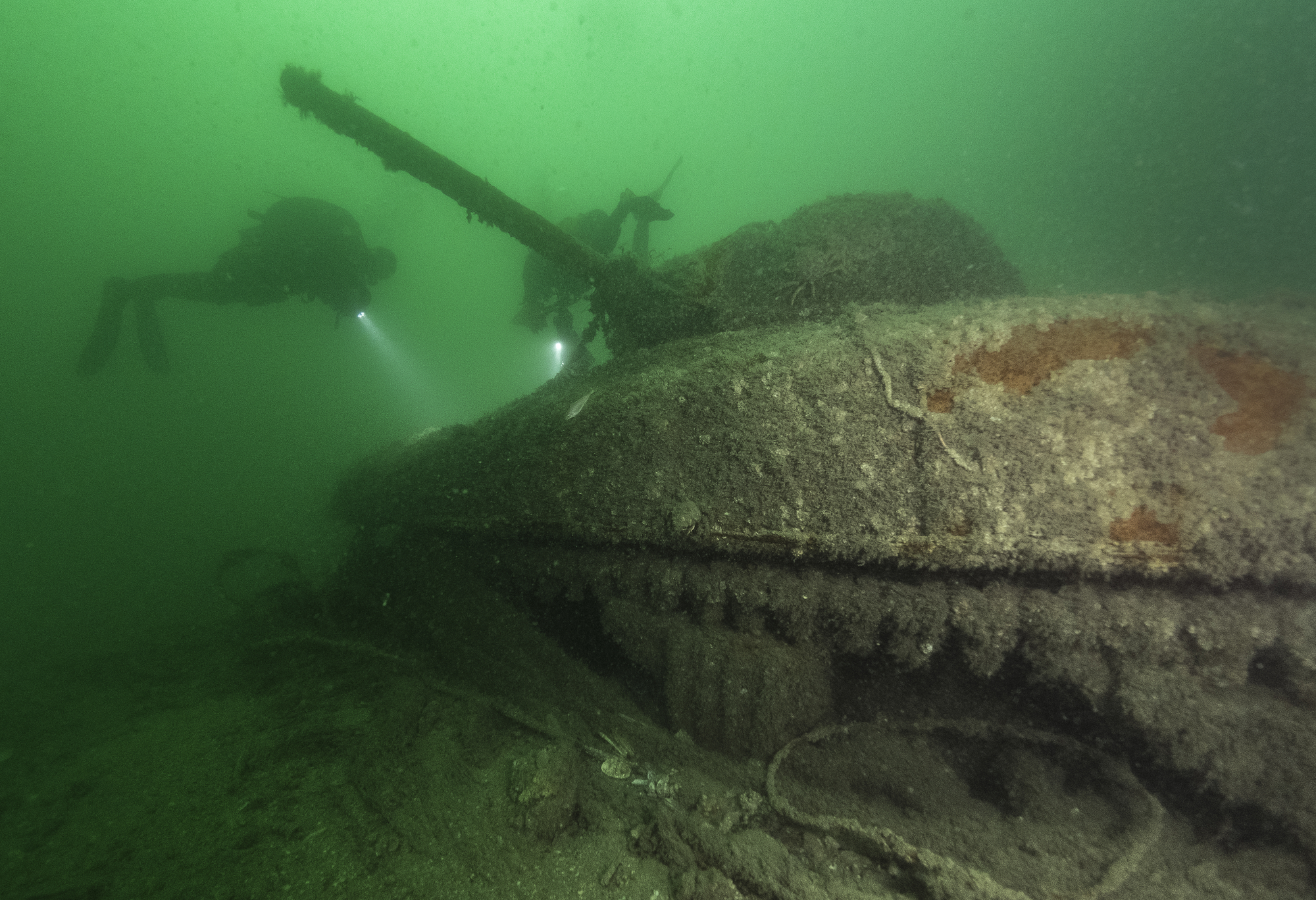
- Home
- Immersion on the wrecks of the Normandy landings
- Transporting equipment
As with transporting troops, the transport of equipment required units of a wide range of sizes, requisitioned or built specifically for the Normandy landings.
Ocean-going ships
LSTs, cargo ships and Liberty ships
Beginning in 1942, the Allies developed a vast programme for the construction of large landing ships. The largest of these were the Landing Ship Dock (140 m long) and the best known were the Landing Ship Tanks (LSTs). The famous Liberty ships, of which 2,751 were built between 1941 and 1945 in the United States, were cargo ships rapidly manufactured (70 days on average) from prefabricated components. Among these, some 236 of them took part in Operation Neptune. Existing freighters were also requisitioned in addition. Today, six cargo ships, two LSTs and three Liberty ships involved in the Normandy landings are resting on the seabed of the Baie de Seine.
An LST that is difficult to identify
Landing Ship Tanks were cargo ships of about 100 m in length, capable of crossing the Atlantic or the Channel and unloading vehicles onto the beaches. They were designed to run aground on the beaches, unload at ebb tide, thanks to their opening bow, and leave with the high tide. On D-Day, 236 LSTs were deployed. One wreck, called “Carbonel” or “tank barge” by Norman divers, is generally thought to be LST 523. Built in 1943, the latter struck a mine on 19 June 1944, on its way to Utah Beach to unload a cargo of trucks, jeeps and 15 tonnes of dynamite, with 201 men on board. However, this wreck is not found in the area where the accident occurred. The dimensions of this site (nearly 100 m long) and its still visible cargo (tanks and jeeps) lead us to believe it is another LST, as yet unidentified.
The Charles Morgan
The Charles Morgan, built in 1943 in Houston (Texas), was a Liberty ship of standard design, measuring 134.5 m long and capable of transporting 9,146 tonnes of cargo. Assigned to D-Day operations, it was hit by an aerial bomb on 10 June, while unloading its cargo at Utah Beach. After an unsuccessful towing attempt, it was dismantled on 13 June, then scrapped after the war. A wreck that is commonly thought to be one half of this Liberty ship, has yet to be confirmed because the nature of the site does not facilitate identification. A second wreck, north of Graye-sur-Mer, may correspond to another Liberty ship, the Charles W. Elliot. On 28 June 1944, after discharging fuel at Juno Beach, it struck two mines, while at anchor. Both halves of the ship were towed into deeper water before the bow was bombed by the Germans.
Landing Crafts and Landing Barges
Valuable archives
Accompanying the large vessels were numerous smaller units, called Landing Craft (measuring up to 60 m in length) and Landing Barges (measuring up to 30 m in length). More than thirty small units for transporting equipment are still preserved on the seabed of the Baie de Seine. For many of them identification may be possible by comparing the site plan with an archival document issued by the US Navy on 7 April 1944. Providing a sort of catalogue of these units, type by type, it records the dimensions, plan and section of each model. This document is an invaluable resource for identifying the wrecks. During the verification campaigns conducted by the DRASSM all acoustic data obtained for these landing units was subsequently compared with this catalogue.
Identifying a barge
A wreck located in the Banc du Cardonnet area was previously reported to be a “LCT type barge”, a landing craft for tanks. Although the wreck was not precisely located in the SHOM database, it was easily found on the sonar image obtained in 2013 by Andy Sherell. The shape of the remains, and above all, the dimensions derived from a second survey carried out in 2018 by the DRASSM make it possible to re-interpret this site as a smaller barge, of type LBE, LBV or LBF, built from similar plans. An assessment dive would complete this initial analysis. For example, the internal fittings of a barge or the contents of its cargo can positively identify it as a transport barge, loaded with the prefabricated components of a Bailey bridge, or used to unload armour on the beaches.
Partners and authors
Associated media
Open Media Library

Multibeam echo sounder survey of the Landing Ship Tank

Inverted tank

Rudder, on the wreck of a Landing Ship Tank

The Liberty ship Charles Morgan
Multibeam echo sounder survey of the presumed Charles Morgan

Barge unloading equipment on a beach in Normandy

Extract from the Allied Landing Craft catalogue (LBV page)
Multibeam echo sounder survey of the barge type LBV

